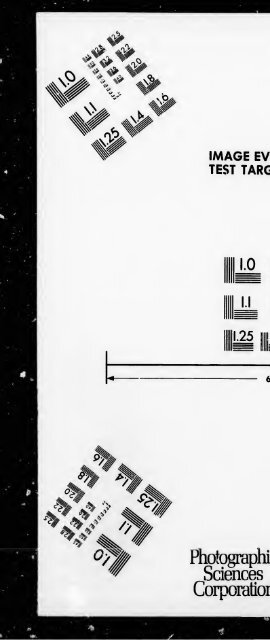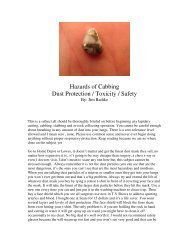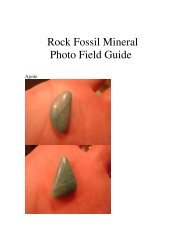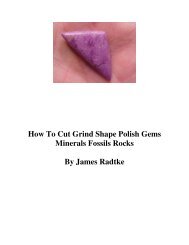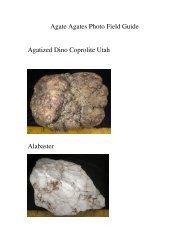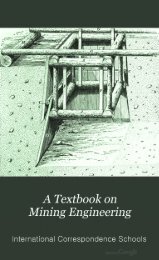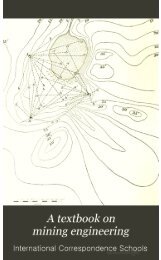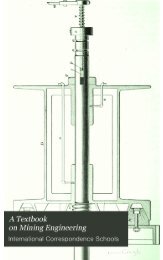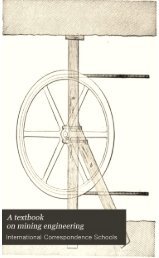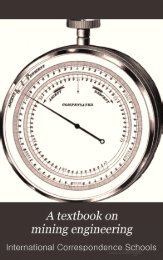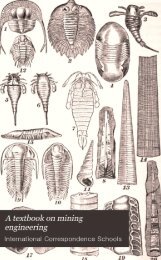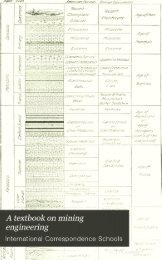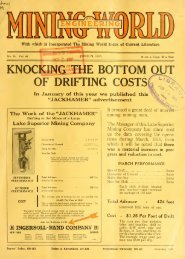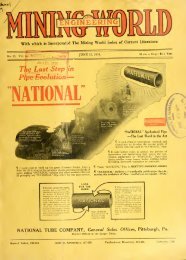You also want an ePaper? Increase the reach of your titles
YUMPU automatically turns print PDFs into web optimized ePapers that Google loves.
IMAGE EVALUATION<br />
TEST TARGET (MT-3)<br />
1.0<br />
IM<br />
li.O<br />
I.I<br />
1.25<br />
biUt.<br />
1.8<br />
1^ W<br />
V]<br />
u.&^<br />
CIHM<br />
Microfiche<br />
Series<br />
(l\/lonog raphe)<br />
ICMH<br />
Collection de<br />
microfiches<br />
(monographies)<br />
Canadian Institute for Historical IVIicroreproductions / Institut Canadian de microreproductions historiques<br />
\;\<br />
vV<br />
;i^
Technical and Bibliographic Notes / Notes techniques et bibliographiques<br />
The Institute has attempted to obtain the best original<br />
copy available for filming. Features of this copy which<br />
may be bibliographically unique, which may alter any<br />
of the images in the reproduction, or which may<br />
significantly change the usual method of filming, are<br />
checked below.<br />
Coloured covers/<br />
n Couverture de couleur<br />
Covers damaged/<br />
Couverture endommagee<br />
Covers restored and/or laminated/<br />
D Couverture restauree et/ou pelliculee<br />
D<br />
Cover title missing/<br />
Le titre de couvertumt manque<br />
Coloured maps/<br />
Caites gAographiques en couleur<br />
Coloured ink (i.e. other than blue or black)/<br />
Encre de couleur (i.e. autre que bleue ou noire)<br />
L'Institut a microfilm^ le meilleur exemplaire qu'il<br />
lui a eti possible de se procurer. Les details de cet<br />
exemplaire qui sont peut-Atre uniques du point de vue<br />
bibliographique, qui peuvent modifier une image<br />
reproduite. ou qui peuvent exiger une modification<br />
dans la methode normale de f ilmage sont indiques<br />
ci-dessous.<br />
Coloured pages/<br />
Pages de couleur<br />
Pages damaged/<br />
Pages endommagtes<br />
Pages restored and/or laminated/<br />
Pages restaurees et/ou pellicultes<br />
Pages discoloured, stained or foxed/<br />
Pages decolorees, tachetees ou piquees<br />
Pages detached/<br />
Pages detaches<br />
QShowthrough/<br />
Transparence<br />
n<br />
Coloured plates and/or illustrations/<br />
Planches et/ou illustrations en couleur<br />
Bound with other material/<br />
Relie avec d'autres documents<br />
I<br />
I Y I<br />
~| Quality of print varies/<br />
Qualite inegale de I'impression<br />
Continuous pagination/<br />
Pagination continue<br />
D<br />
Tight binding may cause shadows or distortion<br />
along interior margin/<br />
La reliure serree peut causer de I'ombre ou de la<br />
distorsion le long de la marge interieure<br />
Blank leaves added during restoration may appear<br />
within the text. Whenever possible, these have<br />
been omitted from filming/<br />
II<br />
se peut que certaines pages blanches ajout^es<br />
lurs d'une restauration apparaissent dans le texte,<br />
mais, lorsque cela etait possible, ces pages n'ont<br />
pas iti film^es.<br />
Includes index(e$)/<br />
Comprend un (des) index<br />
Title on header taken from:/<br />
Le titre de ren-t£te provient:<br />
Title page of issue/<br />
Page de titre de la I ivraison<br />
Caption of issue/<br />
Titre de depart de la livraison<br />
Masthead/<br />
n<br />
Additional comments:/<br />
Commentaires supplementaires:<br />
I<br />
I<br />
Generique (periodiques) de la livraison<br />
This item is filmed at the reduction ratio checked below/<br />
Ce document est f ilme au taux de reduction indique ci-dessous.<br />
^QX 14X 18X 22X 26X 30*<br />
12X 16X 20X 24 X 28X 32 X
qu'il<br />
ecet<br />
It de vue<br />
age<br />
cation<br />
ques<br />
The copy filmed here has been reproduced thanks<br />
to the generosity of:<br />
National Library of Canada<br />
The images appearing here are the best quality<br />
possible considering the condition and legibility<br />
of the originaS copy and in keeping with the<br />
filming contract specifications.<br />
L'exemplaire film6 fut reproduit grdce d la<br />
g6n6rosit6 de:<br />
Bibliothdque nationale du Canada<br />
Les images suivantes ont 6t6 reproduites avec le<br />
plus grand soin, compte tenu de la condition et<br />
de la nettet6 de l'exemplaire filmd, et en<br />
conformity avec les conditions du contrat de<br />
filmage.<br />
Original copies in printed paper covers are filmed<br />
beginning with the front cover and ending on<br />
the last page with a printed or illustrated impression,<br />
or the back cover when appropriate. All<br />
other original copies are filmed beginning on the<br />
first page with a printed or illustrated impression,<br />
and ending on the last page with a printed<br />
or illustrated impression.<br />
The last recorded frame on each microfiche<br />
shall contain the symbol —^ (meaning "CON-<br />
TINUED"), or the symbol V (meaning "END"),<br />
whichever applies.<br />
Maps, plates, charts, etc., may be filmed at<br />
different reduction ratios. Those too large to be<br />
entirely included in one exposure are filmed<br />
beginning in the upper left hand corner, left to<br />
right and top to bottom, as many frames as<br />
required. The following diagrams illustrate the<br />
method:<br />
Les exemplaires originaux dont la couverture en<br />
papier est imprimde sont filmds en commenpant<br />
par le premier plat et en terminant soit par la<br />
dernidre page qui comporte une empreinte<br />
d'impression ou d'illustration, soit par le second<br />
plat, selon le cas. Tous les autres exemplaires<br />
originaux sont filmds en commenpant par la<br />
premidre page qui comporte une empreinte<br />
d'impression ou d'illustration et en terminant par<br />
la derni^re page qui comporte une telle<br />
empreinte.<br />
Un des symboles suivants apparaitra sur la<br />
dernidre image de cheque microfiche, selon le<br />
cas: le symbole —- signifie "A SUIVRE", le<br />
symbole V signifie "FIN ".<br />
Les cartes, planches, tableaux, etc., peuvent dtre<br />
film^s A des taux de reduction diffdrents.<br />
Lorsque le document est trop grand pour Stre<br />
reproduit en un seul clichd, il est film6 d partir<br />
de Tangle sup6rieur gauche, de gauche d droite,<br />
et de haut en bas, en prenant le nombre<br />
d'images ndcessaire. Les diagrammes suivants<br />
illustrent la mdthode.<br />
1 2 3<br />
1 2 3<br />
32 X<br />
4 5 6
THE<br />
//:<br />
¥\<br />
I<br />
GOLD DIGGER'S<br />
GUIDE.<br />
BY J.<br />
BAILEY,<br />
QUEBEC<br />
PRINTBD BY HUNTER, ROSE &<br />
<strong>1864</strong>.<br />
CO,, ST. UllSULE ST.
I<br />
t
PREFACE.<br />
-••»-<br />
nent, in the<br />
. BAILEY,<br />
In bringing this little pamphlet before the public,<br />
I believe I am supplying a want that is felt by every<br />
one interested in gold mining. The most necessary<br />
information for the gold miner is a knowledge of the<br />
quickest and most successful methods of separating<br />
the gold from the ditterent formations in which it is<br />
found. "Where it is found, rumor and the public<br />
prints will most readily inform him. The " Route to<br />
the Chaudicre Mines," and the short extracts from<br />
the Rev. Mr. Douglas' pamphlet on those mines, will,<br />
I expect, be found useful and interesting. The<br />
directions for mining, and for the making and manner<br />
of using the different tools and machines wanted in<br />
raining, are the result of over four ycar«' experience<br />
in the gold fields in Australia. I might have increased<br />
the pamphlet in volume, by extracts from geological<br />
works, but I doubt whether such information would<br />
have made it more useful to the gold miner. I have<br />
never heard that geological knowledge has enabled<br />
any one to find gold. The California gold mines were
IV<br />
PREFACE.<br />
not d,scoveraa bj, a geologist ; „„r was - a geologist<br />
hat opened the gold mines in Australia; It wa. a<br />
knowledge acquired in<br />
California which induced Mr<br />
Hargraves to return to Australia, and enabled him to<br />
d,scover the gold mines in that country; and it is<br />
such information as<br />
give m the following pages.<br />
he acquired that I have tried to<br />
Quebec, April 20, <strong>1864</strong>.
i<br />
was<br />
.<br />
Jologist<br />
a<br />
ed Mr.<br />
him to<br />
i it is<br />
ried to<br />
CONTENTS.<br />
lOR.<br />
The Route to the Chaudiere Mines<br />
^**1"<br />
Tha First Discovery of <strong>Gold</strong>. .<br />
. ,<br />
Mining for <strong>Gold</strong><br />
Hydraulic Process<br />
Sluicing<br />
The SIuice .........!.<br />
The Long Tom<br />
The "Jenny Lind"<br />
..*.*.' .'....'**'".<br />
Jg<br />
Puddlinnf °<br />
19<br />
How to make a Puddling Machine.<br />
"on ^^<br />
TheCradle<br />
DeepSinlmg<br />
Quartz Mining "<br />
30
THE<br />
GOLD DIGGER'S<br />
GUIDE.<br />
^<br />
The Boute to the Chaudiere Mines.<br />
.<br />
Starting from Quebec, a ferry boat takes you<br />
across the St. Lawrence to Point Levi. Turning to<br />
the right, two or three hundred yards from the landing<br />
place, you ascend a hiJl, a bend to the left, and<br />
again to the right, and you are in Notre Dame de<br />
la Victoire. The hill is now straight for the rest of<br />
its length. At the top you again turn to the right, and<br />
now I may say that you have no more hills before<br />
you worth mentioning. Not quite a mile fi;; I.er on,<br />
you again turn, this time to the left. The celegrapli<br />
has a branch this way from this corner. With the<br />
exception of one or two slight turns, the road runs<br />
straight into St. Henry's. Opposite the church you<br />
cross the bridge over the river "Etchemin." A mile<br />
and a half or so further on, you pass a road on your<br />
left which goes to Frampton, and other back settlements<br />
; still further on there is another turning to the<br />
right (which would take you through the Village of<br />
St. Isidore), but your Avay is straight on, past the<br />
door of a small tavern ; once past this tavern and you<br />
cannot easily get off the main road. Farmers' houses
2 THE ROUTE TO THE<br />
are on both sides of the road as you go, and any of<br />
them will readily prepare you either meals or a bed,<br />
such as they are, for which they make very moderate<br />
charges. In the hotels and refreshment houses along<br />
the road, they seldom charge more than 20 cents<br />
for either meals, or bed. Some I'j or 14 miles from<br />
the bridge, topping a small hill, you have before you<br />
the " Chaudiere River." It is here about 100 yards<br />
wide, and starting from this point, a boat drawing not<br />
more than 18 inches of water would be able to run up to<br />
the " Devil's Rapids" above St.Franc^ois ; but in very<br />
dry seasons, the river in some places has not e vcn enougli<br />
water to float a boat of that draught. From this<br />
point, to I believe 20 miles higher up than St. Fran-<br />
(;ois, the road is along the left bank of the river. At<br />
the top of this little hill, you have the first indications<br />
of a gold country ; to the left of the road, most of the<br />
fields (except those which lie very low) have surface<br />
indications of gold. Quartz boulders, well water Avorn,<br />
lie here and there on the road. The next village you<br />
pass through is St. Mary's. After you leave the village,<br />
you will observe that the road is most of its<br />
length on low flat ground, and on the other side of<br />
the river you will perceive in places the same low<br />
ground, which I believe to have been deposited by the<br />
river. I think that parties Avould have a ricli<br />
return for their labor if they would sink on these flats.<br />
The lower parts of the flats, that is, I mean, Adhere<br />
the stream has apparently made a turn, will I tliink<br />
be found rich.<br />
^<br />
It is probable that they cannot be<br />
worked, except in a very dry season, when the river is<br />
very low, and even then, it would require parties who<br />
had some experience in " slabbing &<br />
;" but I am confident<br />
that if well tried, large " finds " would' be made.<br />
I would here caution parties against travelling this
I<br />
CHAUDIERE MINES. 8<br />
road during the time of the "Spring Flood.s," as I<br />
am tohl the river over flows all those flats I have<br />
mentioned. Every fall the hahitans take the fences<br />
doAvn to save them from ])eing carried away in the<br />
spring, and the traveller will perceive that all the<br />
houses are built just on the edge of the rising ground.<br />
The next parish is St. Joseph's, which is, as I have<br />
said, to the left of the road on the high ground.<br />
Should the "rush to the diggings" he as great as it<br />
is expected, the inhabitants of this village will learn<br />
Avhat they have lost by not having the main road run<br />
along the edge of the hills, and tlirough the village.<br />
Parties who travel " digger" fashion, with their<br />
tents, etc., on their backs, or with a cart, camping out<br />
every night, will be delighted with this road, Ccxcept<br />
in wot Aveather, when I fear it will remind Aiistralians<br />
of the " winter roads " in that part of ^he world).<br />
The scenery is really beautiful, and they need not travel<br />
half a mile without finding good camping ground.<br />
About five miles from St. Joseph, a small stream, the<br />
river " Des Plantes " is crossed. Some gold has been<br />
found on the banks of this stream. St. Fran9ois, the<br />
next parish, is about 11 miles from St. Joseph ; it is<br />
on the right bank of the river, the croosing being made by<br />
a rather primitive sort of a ferry, a strong rope<br />
stretched across the river, and a large "scow " drawn<br />
backwards or forwards as wanted. This kind of ferry<br />
is quite common from St. Isidore up.<br />
Some distance higher than the village is the "Devil's<br />
Rapids," and at this spot on both sides of the road,<br />
are large masses of quartz which it is said contains<br />
gold. It mu t be this reef which crops out<br />
about the middle of the river, at the top of the rapids,<br />
from which a good deal of heavy gold has been<br />
taken. In 185G, in Ar.stralia, diggers first mentioned
* THE ROUTE, ETC.<br />
that (almost invariablj) wherever there Avas a rich<br />
quartz reef, there was a rich gully convenient, and<br />
that at the top of rich "gullys" that had been<br />
worked, rich reefs would be found, and so it proved<br />
in many cases. From rich reefs they traced rich<br />
gullys and at the heads of rich gullys they discovered<br />
rich<br />
^<br />
reefs.<br />
The miners also found that the same reefs might<br />
run tor a considerable distance across the country<br />
cropping out here and there, and again sinking. I<br />
traced one for near 50 miles, and it was workid at<br />
tour different places, at Maryborough, Bet Bet Reef,<br />
feandy Creek, and Kingower, and I have no doubt,<br />
experience will prove it to be the same in this<br />
country.<br />
About a mile above the rapids is the " Touffe de<br />
I'lns or River Gilbert. The road to these diggings<br />
here turns to the left ; it does not run very near to<br />
the ground that has been worked, but should much of<br />
the ground be tried next summer, roads would be made<br />
m all directions by the miners. <strong>Diggers</strong> will labour<br />
under many disadvantages in Canada ; in the first<br />
place, they will have to travel by the made roads, as<br />
it would be almost impossible for them to make their<br />
vray (even without a load) through the bush. And in<br />
commencing to work they will find the density of the<br />
bush, the roots, etc., a great drawback. They will<br />
have plenty of water for almost any manner in which<br />
they wish to work, excepting the ''hydraulic process,<br />
by which method very little will be done, unless<br />
water is Fupplied in the same way as in California.<br />
1 would not advise diggers taking any tools with<br />
them except a pick and shovel, and even these they<br />
will be nnif> tft oppf nt +>i" /ii" f", .,, , J.<br />
- - 0-- - ; '-K-S^"6'^- S^^&i- J-'hcy will do well<br />
to bring a tent With them, unless they determine to<br />
I
THE FIRST DISCOVERY OF GOLD. 6<br />
build a bark shanty or log hut.<br />
tind strong groy cotton, at least<br />
Eor a tent, they will<br />
as good (I think better)<br />
than any canvass or American duck used; it is<br />
also lighter to carry, I would not advise them to<br />
bring much clothing with them ; it will be more<br />
troublesome than it is worth. Good strong boots are<br />
required, such as farmers use. And last, but most<br />
wanted, money enough to stand a run of ill-luck, which<br />
the majority will be sure to meet, even though the<br />
diggings prove richer than either California or s-<br />
tralia.<br />
The First Discovery of <strong>Gold</strong>.<br />
<strong>Gold</strong> was first found in Canada nearly 40 years<br />
a_go. From all accounts, the next piece (about the<br />
size of a pigeon's egg) was picked up, by a jouncr<br />
woman, ma small stream (now called the "<br />
m<br />
Gilbert,")<br />
the parish of St. Fran9ois, county of Beauce.<br />
Her father made further search after the precious<br />
seems, did not find enough to make the<br />
metal, but, it<br />
pursuit profitable. Enough was found, however, to<br />
induce the seigneur to apply for, and obtain, in 1846,<br />
an exclusive privilege to mine ivfith^n tliP Umlfo «f<br />
his seignior^,) subject to certain conditions, which<br />
conditions, it appears, have not been complied with.<br />
I
o<br />
FIRST DISCOVERY<br />
In a very interesting paper read before the Literary<br />
and Historical Society of Quebec, by the Rev. James<br />
Douglas, he says (having mentioned the first discoveries)<br />
:— " Exploration was now carried on vigorously<br />
on the Chaudi^'re and its tributaries, and it<br />
soon appeared that the main river and all its tributaries,<br />
great and small, from St. Marie's almost up '<br />
to Lake Megantic, were charged with gold. Owing<br />
to the sluggishness of the main stream, up to its junction<br />
with the Du Loup, that is over at least 20 miles<br />
of its auriferous bed, nothing more than prospecting<br />
has been done upon it, except at one or two spots<br />
where it has laid bare the ledge, as at the * Devil's<br />
Rapid.' There a highly remunerative quantity of<br />
large gold has been found. But, Avhile all its tributaries<br />
were distjovered to be auriferous, it was found<br />
that, at least below the bend of the river, at the mouth<br />
of the Du Loup, the streams which flowed in from<br />
the west were poorer than those which drained the<br />
ridge on its east bank. These are the Guillaume, the<br />
Des Plantes, the Touife de Pins, and the Famine,<br />
with a number of insignificant<br />
rivulets.<br />
"Where the Chaudi^re and the DuLoup join, they<br />
Hete the Chaudiere<br />
are streams of about equal bulk.<br />
takes a bend and runs almost due north and south,<br />
while the Du Loup flows in from the south-east. The<br />
current of the Chaudiere Lecomes now much more<br />
rapid, and at two spots, at the greater and lesser falls,<br />
both within two miles of the junction, the ledge is<br />
exposed for a considerable distance. At both these<br />
spots gold was early found jammed in the crevices<br />
of the slate. More recently the stream above this<br />
nnint. panpcinllv the S5tafford Brook, on the riffht bank.<br />
^<br />
^ — jj ^ — , j-j<br />
and the Condd, on the left, have been successfully<br />
washed for gold ; the same result has attended the<br />
> i
OP<br />
GOLD.<br />
exploration of the Du Loup and its. tributaries,<br />
the boundary lino of the State of Maine.<br />
up to<br />
" The Chaudierc Mining Company (having leased<br />
the rights of the seigneur,) began operations on the<br />
Touffe de Pins, at a point about a mile from its mouth,<br />
where the river had gradually receded from its original<br />
bed, leaving behind it an extensive flatj covered with<br />
eight or ten feet of debris. Here the company worked<br />
for several years, but so unskilfully and so lavishly,<br />
that the receipts did not cover the expenditure.<br />
It is to be regretted that the first attempt should<br />
have been made under circumstances so little likely<br />
to prove successful, for the signal failure of the<br />
company helped to retard the progress of the mines.<br />
" The DesPlantes was also worked in several places.<br />
At one spot, immediately above the first fall, a rich<br />
deposit was struck upon, which yielded for several<br />
weeks from three to ten ounces a day. Here also<br />
Avas tried the experiment of dry digging. The deluvial<br />
deposit was washed from the hill side, far above<br />
the level of the brook, but not Avith such success as<br />
to encourage the company to proceed.<br />
"It was on this stream, and on the Famine, that the<br />
company Avas Avorking Avhen Lord Elgin visited tho<br />
mines in 1853. On the latter river but little Avas<br />
done, and that on so small a scale as not fairly to<br />
test its capabilities ; as, hoAvevcr, it has always been<br />
a favorite stream Avith the hahitans, it must have<br />
produced a considerable quantity of gold."<br />
In 1851 and 1852 the Canada Mining Company<br />
carried on extensive operations on the flats at the<br />
mouth 01 tiie ajm xjoup. Tuo graved for about ^ qf<br />
an acre, Avith an average thickness of tAVO feet, Avas<br />
washed and yielded 2.107 dwts. of gold, Avorth $1,826.
:<br />
I<br />
8 PIRBT DISCOVBBY<br />
In 1852 about the same extent of ground was washed<br />
and gold to the value of $2,496 was obtained.<br />
'<br />
Since 1855 the diggings have been abandoned to<br />
the habitans, and it is not known whether they<br />
obtained much or little, as it was their interest to<br />
conceal their success, lest tribute should be demanded<br />
of them. Five brothers, of the name of Poulin, seem<br />
to have been the most successful, and in the fall of<br />
1862 they struck on some rich ground, on the banks<br />
of the " Gilbert." The spot is on the north branch<br />
of the river, about four miles from its mouth. Mr.<br />
Douglas says<br />
)<br />
" It was too late in the season when the discovery<br />
was made, to do more than ascertain its exceeding<br />
richness ;<br />
but so soon as the spring freshets had subsided,<br />
they betook themselves to work, and with such<br />
success that the fame of their good fortune spread<br />
rapidly through the parish, and the most impassive of<br />
the habitans flocked to the locality. The river was<br />
explored for about a mile of its length, and two spots<br />
selected as the richest. One on the lot of a man<br />
called Vielleux, the other about 15 acres lower down, on<br />
ground belonging to oneEodrigue. The upper diggings<br />
attracted the greatest crowds, and, up to the middle<br />
of July, Rodrigue himself and three of the Poulins, his<br />
associates, were undisturbed in their possession of<br />
the lower diggings. Within the six weeks from the<br />
beginning of June till near the middle of July, several<br />
acres of ground on Vielleux's lot were thickly perforated<br />
with holes, and the bod of the river pretty<br />
thoroughly washed out, and a great deal of gold must<br />
have been obtained. The largest piece found was<br />
said to have been picked up by a woman named Parrd,<br />
and to have been sold for $88. One party of six,
1<br />
!<br />
OF GOLD. 9<br />
including the two most noted Poulins, acknowledged<br />
finding 15 ounces in three days, and another party, of<br />
the same number of hands, found six and a half ounces<br />
in two days. The lower diggings seem to have been<br />
caused by a bar of hard rock, which, crossing the<br />
stream almost at right angles, appears to have intercepted<br />
the gold in its downward progress, for below<br />
the bar nothing of any consequence has been found,<br />
while immediately above it the yield seems to have<br />
been enormous. The soil became poorer as it receded<br />
upwards. It was first above the bar that Eodrigue<br />
and his company worked the bed of the river, in the<br />
beginning of the season, and- it was here they bought<br />
the location which has proved so rich.<br />
" Up to the middle of July, no work had been done<br />
upon the banks, the crowd being retained at the<br />
uppef diggings, and the bed of the stream afibrding<br />
occupation enough to the four men who composed<br />
Rodrigue's party. They worked 12 full days, and<br />
found, with nothing better than tin pans, 10 ibs of<br />
gold, and, be it said to their credit, they were honest<br />
enough to admit it, and give a quarter in tribute.<br />
The location which, after this, Rodriguc and his<br />
party bought was one hundred and fiTty feet long by<br />
fifty feet wide. They selected a part to work themselves,<br />
and sold the rest, piece meal, at prices which<br />
must have brought them in several times what they<br />
paid for the whole. Their find, after exhausting the<br />
bed of the river, somewhat fell oft*, but while washing<br />
the banks they got, for instance, one day one ft)., and<br />
the following day ten ounces. But it must be remembered<br />
that this was with a sluice, whereas previously<br />
they had used only a tin pan. Their largest
10 fiRST DISCOVERY OP GOLD.<br />
piece was sold for $200 ; the next largest weighed<br />
almost three ounces.<br />
" What they found in all they did not know themselves,<br />
as they frequently sold parcels of gold without<br />
keeping accurate account of it ; but the proceeds of<br />
the summer did not probably amount to less than 24<br />
ibs., which would give 6 Bbs. (worth $1,296,) to each<br />
man, or supposing them to have worked eighty days,<br />
that is twenty days a month for four months, which is<br />
more than they probably did, their wages were per<br />
man over $15 a day. One day Rodrigue, working<br />
alone with an old man, found two ounces two pennyweights<br />
and eight grains, worth $38.<br />
" The conditions under which the alluvial gold is<br />
found vary with the diflferent character of the river<br />
beds. The Des Plantes, between the lower and upper<br />
falls, where alone any mining has been done, is narrow<br />
and precipitous; there is, therefore, but little<br />
depth of deposit upon the ledge, and that of a gravelly<br />
nature ; hence the gold is found in largest quantity<br />
upon the ledge. The bed consists of a hard grauwacko<br />
schist, dipping almost perpendicularly, and interstratified<br />
by large dykes of serpentine. Above the second<br />
fall its character totally changes, and it runs sluggishly<br />
over a kind of plateau. This part has not been<br />
thoroughly explored. The Touflfe de Pins is also rapid,<br />
but the valley through which it runs is seldom so<br />
narrow. Betfs of clay alternate with those of gravel<br />
to the depth, sometimes, of eight and twelve feet, and<br />
a stiff clay, when lying immediately upon the slate,<br />
is often as rich throughout as where it rests upon the<br />
ledge. This was the case at several spots at the Rodrigue<br />
mine. The bed is composed of dark slate, very
MINING FOR GOLD. 11<br />
open in its cleavage. The Famine resembles generally<br />
the Touffe de Pins ; but about a mile and a half<br />
aboye the falls, that is about five miles from its mouth,<br />
there commences an extensive deposit of clay, sand<br />
and gravel. Where gold has been most extensively<br />
Avorked in the Dd Loup, that is at its mouth, the<br />
deposit is composed of loose gravel, averaging not<br />
above two feet in thickness."<br />
In the explorations for copper mines during the<br />
last fall, it is said that gold has been discovered in<br />
many localities in the eastern townships ; but as there<br />
may be but little truth in any of these reports, perhaps<br />
it is as well not to mention the places named.<br />
Mining for<br />
<strong>Gold</strong>.<br />
— o-<br />
<strong>Gold</strong> is very often found on the surface, in a mixture<br />
of sand, quartz, iron-stone, slate pebbles, and<br />
other stones ; sometimes precious stones are found in<br />
this kind of aurfaco earth.<br />
Where water can be obtained from 40 to 50 feet<br />
above your " surface," and you have a good outlet<br />
I.
12 MINING<br />
for your " tailings," the " hydraulic process " will be<br />
found the most profitable way of working surface.<br />
In California, where they have great water power,<br />
they wash away the top earth to a considerable depth,<br />
to get at the "washing stuff," which contains the<br />
gold, and which lays generally on the bed rock. On<br />
the Chaudi^re, places may be found where a good<br />
"head" of water can be obtained; in such places<br />
parties can go to work in the following manner :—It<br />
is only hills or higli ground which are worked by the<br />
hydraulic process. A ditch or " ground sluice " is<br />
dug all round the base of the ground you intend to<br />
work ; from its lowest part, this ditch is continued to<br />
your sluice (a description of which will be found<br />
further on). The sluice should not have a greater<br />
inclination than from four to eight inches in<br />
12 feet ; at a greater inclination than eight inches you<br />
are liable to lose fine gold. From where you have<br />
your head of water, you require a strong hose made<br />
of hide or strong canvass, terminating with a pipe<br />
and nozzle, such as is used with "fire engines."<br />
In most parties, one man can manage the pipe, and<br />
with it soon Avear holes and furrows in the earth ;<br />
commencing low and working up, in this manner the<br />
descending water carries all the loosened earth into<br />
the sluice. When you have got well to work, large<br />
masses of earth can be loosened ; when this is done,<br />
the earth should be broken up either with picks or by<br />
the force of the water, and the pjirty can be variously<br />
employed, seeing that the earth is conveyed to the<br />
sluice, keeping the sluice clear of large stones, roots,<br />
etc., which often dam it up, and cause the water to<br />
run over the side of the sluice, carrying the gold<br />
along with it.
—<br />
FOR GOLD. 13<br />
a Sluicing " as it is generally worked iu Australia,<br />
and as it will bo worked in Canada, does not require<br />
much water. A very small stream, such as the " Des<br />
Plantes" or the "Gilbert," in the driest seasons, will<br />
supply enough water for all the sluices that could<br />
possibly be worked in the neighbourhood of those<br />
streams ;<br />
about 12 square inches of water will work a<br />
sluice of 14 inches wide. " Surface " will generally<br />
be found on hills, and can be worked with a sluice,<br />
*'<br />
long torn," or cradle. Where you can get a head<br />
of water, even a fcAV inches higher than the "surface,"<br />
you can very profitably employ a sluice.<br />
Place the top length of the sluice on the lowest part<br />
of the ground you intend to wash, having the .water<br />
(about eight or ten inches will bo found sulEcient)<br />
conveyed to your sluice by a common canvass hose,<br />
or wooden "dal" or spout. Have your sluice at a<br />
proper inclination ; if the gold is very fine, about four<br />
inches in twelve feet will be found sufficient. One or<br />
two men, at each side of the sluice, are kept constantly<br />
at work, picking up the surface and shoveling it into<br />
the sluice. When the surface has a "slate" bottom<br />
you had better pick up the slate to some depth,<br />
breaking it up small enough J;o lay in the bottom of<br />
the sluice ; and one of the party will be profitably<br />
employed using a knife to scrape the pieces of slate,<br />
and throw them out of the sluice, when clean. As I<br />
have said before, you must prevent the sluice being<br />
filled up with roots or stones.<br />
Once a week or so, generally on a Saturday, you<br />
"cleanup," as it is called. You commence at the<br />
lower end of the sluice (a), allowing but very little water<br />
to run ;<br />
you take out the " rifiie," and carefully wash
;<br />
14 MININa<br />
>
'<br />
FOR GOLD. 15<br />
lengths of boxes, made as follows : the bottom of the<br />
box is covered with a false bottom<br />
of blocks (a) four inches<br />
high, cut off the end of a<br />
square log. These blocks must<br />
be one inch less in width than<br />
the boxes, and when fixed in<br />
the box, must have a space of<br />
half an inch between each<br />
block, and the same between<br />
the blocks and the sides of<br />
the box. A piece of board<br />
wedged between the blocks<br />
and the sides, and nailed,<br />
keep the blocks from moving.<br />
The corners of the blocks,<br />
about three inches, are cut off",<br />
leaving triangular spaces at<br />
the sides of the box. These<br />
boxes will be found to save<br />
the finest gold, and there arc<br />
many companies using them,<br />
who believe they are as efficacious<br />
as quicksilver in saving<br />
fine gold.<br />
In a sluice, most of the<br />
gold should be caught in the<br />
first three or four rifiles,<br />
and when quicksilver is used<br />
instead of the boxes, Avith block bottoms, it IS<br />
used as follows : when the sluice has been worked an<br />
hour or so, sand, etc., will be found lodged against the<br />
liivo. \^oiniiieiiv,iii^ at tiic; luurtii riiiiu, vou lay on<br />
the top of the sand, a shallow bed of quicksilver the<br />
whole widtL of the box. Three or fourriflSes serveil in
19<br />
this rnann*?!- will be found cnouffh VJh^r. i •<br />
"P, the qu/cUil,,. must be s rainr!l * '^'T"«<br />
chamois leather (n J7>. IZi .L ^^^^^."^^^ throngh a<br />
the residue, by beL hol^i<br />
^?\'^ separated from<br />
of sheet ironKT^I'rt^^^^^^ '''' ^^^^^ (- piece<br />
Is made<br />
MINING<br />
F<br />
THE " LON(i lOM"<br />
.18 per cut -the bottom board („)<br />
two abn,.t<br />
feet ,vide, a,,,! from foWteen<br />
sixteen to<br />
feet long, „f one inel stuff<br />
the mrtes of the »ame thiekness, ami<br />
ban the bottom. From the end of fhe<br />
pit at a slight currc. Thick shoof<br />
u^onofthesamewidtha^liXttm'<br />
and four o,- five feet »<br />
long, is<br />
quired r":<br />
for the "Tail<br />
mencmg *.'-' Com<br />
one foot from the end it i."<br />
perforated with holes about a<br />
of an<br />
quLer<br />
inch in diameter (about<br />
every<br />
one h^<br />
.neb) for two feet in C<br />
7"fthtswf-''''^'"-''"'""^-'<br />
the sneet iron is sunk its o-im<br />
tiuckness in the bottom board the<br />
perforated part of the tail beW<br />
clear of the bottom board.<br />
neath,<br />
vlZ.<br />
and supporting the end of the<br />
rrffl""?, '"'^''^' " " '""' (called<br />
Riffle a<br />
Box, d) two inches wider<br />
the<br />
than<br />
torn, and three feet long,<br />
abou,-n: and<br />
inches deep; it is ciided<br />
same tm ;;: ;,ri the sidos.
FOR GOLD.<br />
IT<br />
f<br />
The torn must have an inclination of twelve or<br />
fifteen inches in the length of it ; the riffle box must<br />
have the same inclination. The stuff to be washed<br />
is thrown into the ujmo end of the torn, where it is<br />
worked aboui »^ith a shovel, until all the earth and<br />
clay is w oil sepa'ated from sand, etc. ; o'' this done,<br />
'<br />
the*»vatri irries it to the lower end of the torn, where<br />
a secona man stands, who passes all he can through<br />
the tail of the torn, throwing off the tail all that will not<br />
pass, first seeing there arc no nuggets among the<br />
stones.<br />
The small pebbles, sand, and gold, fall into the<br />
upper end of the riffle box, and as there is a constant<br />
fall of water into the box, the gold is carried under<br />
the sand, and lod'^es against the cross piece ; when<br />
the gold is very fine, a shallow box (t?) to contain<br />
quicksilver, about three inches wide, is made to fit<br />
the lower end of the riffle box. It should be firmly<br />
fixed, at the same height as the end of the riffle box,<br />
and present a surface of quicksilver three inches in<br />
width, over which all the sand, gravel, etc., has to<br />
pass, and it will be found to save most of the fine gold,<br />
which would otherwise escape.<br />
at<br />
In the evening, the sand, otc, in the riffle box is<br />
*' pannod off." The -i^nicksilver is strained through<br />
a stou J piece of chamois skin, care being taken to<br />
leave but little quicksilver amalgamated with the gold,<br />
as in the ordinary way of separating the gold from<br />
quicksilver, the silver is lost. This is generally done<br />
by holding the amalgamated gold and silver on a<br />
shovel over a fi^e : the quicksilver evaporates, leaving<br />
the gold behind.<br />
J>
18<br />
MINING<br />
((<br />
THE JENNY LIND.<br />
A "Jenny Lind " is made in the same manner as<br />
a "long torn," but only half the length. The " " tail<br />
IS made something wider than in the "long torn "<br />
and has the riffle box " to correspond<br />
'J in width, and<br />
the only difference is in the working, one man being<br />
sufficient to work the "Jenny."<br />
He first puddles, or<br />
washes the earth at the top, and then passes it throuijh °<br />
the tail.<br />
The simplest and most necessary tools the digger<br />
must have, are a pick and shovel, a large tin "nan "<br />
'<br />
o P^n<br />
and<br />
^<br />
"riddle."<br />
The pick should be light in make, about 16 inches<br />
from point to point, (one end shaped like a chisel), and<br />
not more anchor than about three inches in the whole<br />
length; it should be pointed with cast steel. With<br />
such a pick, a miner will do more work, with much<br />
less fatigue, than with the large pick commonly used.<br />
In "deep sinking" or "driving," a short pick<br />
with only one poin^ called a " driving pick " is used.<br />
It has a hammer head with which to drive the pco-s<br />
(used in " slabbing ") or wedges or nails, as required.<br />
The shovel should be light, with caststecl blade,<br />
and round pointed. The large tin " pan " is used in<br />
every process of washing earth for gold. It should<br />
be about 18 inches wide at the top, about 11 inches<br />
at the bottom, and about five or six inches deep. A<br />
smaller pan called a riddle is required ; it is about<br />
two inches less in size in every way, and has the bottom<br />
perforated with holes about a quarter of an inch<br />
in diameter. The " pan " and " riddle " are used as<br />
follows :—The largo pan being full of water, the riddle<br />
is filled (with the stuff to be panned) and immersed
:<br />
FOR GOLD. 19<br />
4<br />
m the largo pan, where it is shaken until all the sand<br />
and fine gravel has passed through. Before throwing<br />
out the gravel in the riddle, see that there are no<br />
"nuggetts " in it. Having shaken your large pan,<br />
pour oft' the water, allowing it to carry away all the<br />
top part of the sand and gravel ; again and again<br />
fill the pan with water, and shake and pour off" until<br />
you have very little left in the pan. You then tilt<br />
the pan up on edge, and allow the water to flow into<br />
your pan and out again ; do this again and again<br />
each time you do so, some grains of stone and sand<br />
are carried away until nothing is left but the gold.<br />
Working with the large pan is called " panning,"<br />
and it matters not what way you may have to wash<br />
the earth, you will have to finish the process by<br />
"panning."<br />
Under surface is generally found a stiff" clay, whicli<br />
often contains a considerable quantity of heavy gold.<br />
The only advantageous way of washing this clay is<br />
with a " puddling machine. ' ' The site for the machine<br />
must bo on ground sufficiently high to have a good<br />
outlet for your slusli, and yet where you can get a good<br />
supply of water, either from a running stream or by<br />
pumping. Two horses and three men are required<br />
to work a puddling machine ; one to cart clay, the<br />
other to work the harrows in the machine, and one<br />
man to pick up the clay and assist in loading the cart.<br />
Having half-filled the machine with water, as soon as<br />
two or three loads of clay have been thrown in, the<br />
horse at the machine commences to work the action<br />
of the harrows mixing up the clay with the water.<br />
Both horses arc kept constantly at work ; but whenever<br />
the clay is found to bo dissolved, the top slush is<br />
allowed to run off through the outlet in the machine.
20 MINING<br />
If there is but little sand or gravel and stone in<br />
the clay, the machine can be worked for six or eight<br />
days without being cleaned out, but generally the<br />
machine is "washed up" once a week—or Saturdays.<br />
The horses are stopped, and you pass the stuff remaining<br />
in the machine through a " long torn."<br />
i %<br />
Clay containing but very little gold pays well<br />
worked in this mai-ner. Supposing you have to cart<br />
your clay half a m)lc, which you have to do in some<br />
cases, 15 loads ought to be made every day ; this at<br />
two pennyweights of gold to the load of 40 buckets<br />
of clay, will give one ounce, ten pennyweights a day ;<br />
7| ounces for the week's work, which, at $18 an ounce,<br />
will give $135 a week. As I have said before, three<br />
men and two horses can do this : one man and horse<br />
to work the machine, one man and horse to cart the<br />
clay, and one man to pick up the clay and help to<br />
fill the cart.<br />
Of course, when the clay Is convenient to the machine,<br />
less gold in the clay will pay ; for with plenty<br />
of water, 60 loads of clay can be puddled in lO.hours'<br />
work.<br />
HOW TO MAKE A PUDDLING MACHINE.<br />
A site being chosen, on an elevated position (so<br />
as to have a good escape for your "slush"), where you<br />
can get a plentiful supply of water, either from a stream<br />
or by pumping, and as near to the clay as possible,<br />
you commence as follows: Strike a circle 80 feet<br />
in diameter; from the same centre a second circle<br />
lines, you excavate to the depth of three feet six inches,<br />
which will form a circular drain, the bottom being
;<br />
lOR GOLD. 21<br />
1<br />
Mllr<br />
T<br />
left about one foot less in width than the top.<br />
Pieces<br />
of wood, from three to four inches square, arc let<br />
into the sides and bottom of the drain, on which to<br />
fasten staves of wood ; the side staves- being put on<br />
first, care being taken to make the joints good. A<br />
block* of wood, 10 or 12 inches in diameter, is firmly<br />
fastened in the centre, and into it an iron spindle.<br />
A cross is then made of wood, about 6 inches square<br />
and 28 feet long, which will give arms of 14 feet<br />
one of the arms is left about 3 feet longer than the<br />
others, to hich v is attached a " Whipple bar." Four<br />
harrows are made from limbs of trees, in thjD shape<br />
of a V, in which are fixed a number of stout iron<br />
teeth, 8 or ten inches long ; these harrows are attached<br />
to the arms of the cross. A small drain conducts<br />
water into the machine, and in the side of the machine<br />
next to the low ground one stave is left out, and the<br />
vacant space filled up by short staves six inches in<br />
length. These pieces are fixed so that they can bo<br />
taken out, to allow the slush to run off.<br />
The machine is half-filled with water, and as soon<br />
as two or three loads of clay are thrown into different<br />
places in the drain, the horse at the machine commences<br />
to work ; the action of the harrows mixes up<br />
the clay with the water ; both horses work away until<br />
the clay and water are well mixed. The horse in<br />
the machine is stopped occasionally, and one of the<br />
small pieces of board being taken out, the top part<br />
of the slush runs out.
22<br />
MINING<br />
^ro. what I h.ve seen of the gold fields on the<br />
Chaudi^re, " I think<br />
the
FOR GOLD.<br />
<strong>23</strong><br />
of the head of the cradle. Pieces of wood (a) ' an in.I,<br />
depends fhesavt; ofit^ZV^Pl inclination,<br />
rockins? nml ";«"','"»'<br />
well mixed up when ,^e '"f' ?'' *" ^'"ff '«<br />
the top is poured off Tl',„<br />
,?'•'' ''"^'""'''' *'»'='
24<br />
MINING<br />
,«Hot&tS"4:X-»'/^ -. a piefe<br />
and<br />
'ong, ana the two pais alrlV "V"' ^"y 3" feet<br />
who ha,l never befoHorkcd 1^ "ontioned. A man<br />
m the vieinitvof other<br />
holes C"?h^ *?"!'' ''"^<br />
can see which way the T^ZL ^' *''°^'' •'"'es you<br />
mclination of the Jp the 1°''/"'" *>»<br />
you p intend<br />
P'^^able obabl^d' to<br />
depth<br />
sink.<br />
of the hole<br />
fi^^S'^::::i4:i:^]:if ^y, .ou<br />
^^o^xn^s oTa4r^'r^^^^^^^^^ -<br />
on which to<br />
p ace The foot<br />
'^"'•"^^ ,!:iF'""'f *''«''oIe<br />
hoisting the ""'teriallj<br />
stuff The ' ,<br />
assist in<br />
Austratia was, l?"there were twT "^ T'"»S '"<br />
for each to work alternatdy in S Zl<br />
'" '^"^<br />
one wou d sink 8 or 10 ;„„i''<br />
P"'?'<br />
'J^hole and on top •<br />
FOR GOLD.<br />
26<br />
spot for your '< wash dirt," you i?et \f im t«<br />
passed all the stuff in the tub thi'm,^. f? ^l ^<br />
the hopper is taken off and Ife sMk S^outT/d<br />
" '<br />
iddle?" M •; "' "? "^' '^ ^^h^d off ?nt; the<br />
*1»»' P"t'cs will<br />
)Jf.Jil'<br />
cradle 4 or 5 tubs<br />
before they pan off,<br />
Most parties have a frame,<br />
as before described.<br />
on which to work tl,n<br />
cradle, but a piece of wood, well fixed in tl,I ,<br />
under each rocker, will an wlr The hoH^.„^7".?''<br />
cradle should be at '"<br />
an in2a ion in the orabou foot, and Lcl es<br />
when fitting the slide ;„n„i^<br />
allowance should be made soVs tohave<br />
and<br />
both the'^ll^<br />
bottom of the cradle at a proper i^ctatt.<br />
"'" '<br />
oftrn;""::.:r^f.r"[ar^''''^ "'''^' ""= '»''<br />
10 inchei^„;k^eC Im Cs::i: s itLr<br />
which ,s made wUh spindles. A heavy piece of wood<br />
E
26<br />
MINING<br />
is left attached to one of tl,„ „<br />
a crooked lb to answeV araT^"'^?<br />
'<br />
'"S''''""" "-<br />
the barrel you have four n!.. "I.'"'<br />
^° ^"Pport<br />
length, which are crosse TneS<br />
"^ he e^'*""'' "l""'<br />
wl "" n" ';'" together *' """^ t'^s are<br />
Hhen all the " wash «»,;«•.' ,<br />
torn of the hole, a<br />
" dr ve - js Z'"^? ''"'" "'» I""-<br />
encroached o„, "pyom- ev'et^ 3 o^ 4 Lt': '"'','.''''">'« '« be<br />
"washdhV' and inf /""''"'"•' y»n take<br />
t.^.-a. you dlv;r..frthf^.J^^<br />
feet square of earth driven ouTT<br />
•>'»\i''"'e 5 or 6<br />
"'.with a piece<br />
about 2 4"/"'''^ ''""''
FOR GOLD.<br />
2T<br />
h m which to fix<br />
^' To support<br />
wood of<br />
silt Z F^'''^\^' ^""'^'^ ""'''' J^'" t^«'^ther to<br />
equal<br />
roo.irpri .<br />
IS, and<br />
a''1 ''""^'"S' f' considerabk) clipital is<br />
icquued,<br />
ties<br />
and arc<br />
when once they have the hole started<br />
n from and the<br />
7Mn^f''''T'^r' ""ightandday," "Sunday<br />
Monday,<br />
bot-<br />
"without stop or stay.'' The nrincipal<br />
(a drive reason<br />
is<br />
for<br />
the<br />
working at it without intermission,<br />
:ion).<br />
^" "" *^^^"^' ^^^"ch is<br />
ust aboTc the<br />
1Z!TI ''^i'' "r^"^<br />
often<br />
avoided by quick sinking.<br />
^t liahh Before to be<br />
commencing to sink, some time is required<br />
to prepare<br />
five, you take<br />
materials, etc. On the ground on hick,<br />
vou<br />
which<br />
wash<br />
have<br />
it.<br />
determmed to sink, logs 10 or 12 inches in<br />
lid diameter<br />
it are is not<br />
dovetailed<br />
so<br />
together, and built up in tiers,<br />
the size of the shaft you are going to sink (generally<br />
^f' your claim<br />
4 leet BIX inches by 2 feet six inches). I.og.s ari<br />
built<br />
Li<br />
have up in this<br />
5 or 6<br />
way, so that the earth whicli is taken<br />
should ou from the be<br />
holes put<br />
has not to be carried any distance,<br />
but IS emptied from the bucket over the edge of tTe<br />
you platform<br />
run<br />
made on but<br />
the logs. Timber split into slabs,<br />
^S in on jou.<br />
rimmed<br />
^considerable<br />
with an adze to an equal thicknek and<br />
the<br />
then cut in sets<br />
miners,<br />
of four of an equal width, two pieces<br />
ot<br />
on the<br />
30 inches long, care<br />
and the other two pieces of GO<br />
inches long. The short pieces must have the ends<br />
>f earth<br />
exactly square<br />
vary<br />
3 inches from the ends of the long<br />
:o commence<br />
pieces, two or three holes are bored of 1 inch in diameter,<br />
fan and<br />
in pegs<br />
from<br />
of wood made to fit the holes.<br />
some number<br />
A<br />
of set,s niansome<br />
commencing other<br />
the shaft, if is sunk down 4 or 5 feet<br />
of these slabs will bo required. In<br />
and<br />
>09e the<br />
drift bottom having<br />
of<br />
been made perfectly level, a<br />
set<br />
or of slabs<br />
quicker<br />
are put in. Of course each set must be<br />
ses sprino-.s<br />
nLmf^?r T^'^^- , 'P'' ^°"S slabs are put in first,<br />
and then the<br />
1 pumn.si short fo<br />
slabs are put between tlfo Ion., sl^ba<br />
1 cap on it<br />
;<br />
f.<br />
X<br />
and driven towards the ends until the pegs'"Snrbe<br />
put into the holes. In this way a box is fo?med, the
28 MINING<br />
Sides being kept in their place by the ends, and the<br />
eiids kept in their place by the pegs, which prevent<br />
the earth from pressing in the ends. You must be<br />
very particular putting in the first set of slabs, having<br />
them perfectly level, and as square in shape as possible,<br />
as the first set put in is the rule or guide for all<br />
the rest<br />
;<br />
set after set arc put in until they are as high<br />
as the first tier of logs, from which strips of hoop iron<br />
are fastened down the sides and ends of the shaft<br />
which keep the sln])s from sinking as you get down!<br />
l;or a deep shaft you require a good windlass; the<br />
uprights are morticed into the top logs, and are well<br />
braced together and made perfectly solid ; the barrel<br />
ot about twelve inches in diameter, working on<br />
iron spindles, and made to woiJc with as little friction<br />
as possible<br />
;<br />
iron handles with a good leverage will t be<br />
required. b u^.<br />
Two thirty-gallon kegs are used for hoisting the<br />
""^^P® '^<br />
a\-u 1<br />
P"^*^ ^" ^^^^ one end of the barrel,<br />
and the kegs are put on, so that one is going down as<br />
the other comes up, the weight of the bucket e:oinff<br />
clown being an assistance in raising the other<br />
Two men are required at the windlass and one in<br />
the shaft<br />
;<br />
the rest prepare the slabs ; at night they<br />
work m watches of four, two at the windlasg^ one in<br />
the shaft, and one to have slabs, etc., ready.<br />
The man m the shaft,<br />
^ having sunk eight or ten<br />
inches, signals for a set of slabs of a given width<br />
they •<br />
are lowered down, and he fits them in, fixing<br />
^<br />
them close to the set above.<br />
Where the ground is soft and loose, it requires<br />
considerable time to get in a set of slabs. In some<br />
ground, a set every six hours is considered good work<br />
and m wet ground, it is sometimes impossible to sink'
v<br />
FOR GOLD. 29<br />
Unless a number of shaft? are sunk at the «amo time<br />
in this way, or a number of men continue bailin^r at<br />
the same time, the water is (lilficult to be got under.<br />
As I have stated before, by having the work .m on<br />
quickly, you sometimes escape a great deal of water.<br />
A. soon as you sink a sufficient depth for a .et of<br />
slabs the water finds its way through the loose earth,<br />
and if not quickly stopped by the slabs being ,)ut in<br />
hrNn^'r''^f'' ^"•J brings with it the ca?th from<br />
l)c»jin(ahe siabr,, and the shaft is lost.<br />
T<br />
I remember worknig at a shaft for two months lanng<br />
aii.l<br />
.o abandon it; we could not get lower than<br />
sixteen feet It was in Spring Hill Gully, at Creswick<br />
s Creek, twelve miles from Ballarat. The cull<br />
rtfd'tr''k''^^r<br />
""^'^^ '^ ^^^« than two<br />
f<br />
claims<br />
in width. T\ e struck a drift 4" water, about sixteen<br />
feet down, and allhough we bailed night and day for<br />
ir.'hf?/f'^'''"^^^''.S'* ^^' ''^^'' «nder, and<br />
of square, it was not safe<br />
trk f W *i"^i'!^<br />
to<br />
woik t We took the slabs out, filling up the hole<br />
sunkt th^/ '\'^f'^' ''''''' ^'^' ^^ ^ff^^'> twice we<br />
in the clay, but ^ouU as soon as we got through the<br />
master ns; and^s<br />
'J^^J^f.^^'^'<br />
some^of tlie<br />
claimg higher up on the lead were bottomed without<br />
' ^^'^^^"g^ith the others,<br />
oU\^^ f abandoned our<br />
claim. Two years after, the summer<br />
dry bmng a very<br />
one, diggers again went to work in thit gully,<br />
and claims<br />
man.<br />
on the lead paid from ^500 to £2 000 a<br />
'<br />
When the shaft is bottomed, you sink four or five<br />
feet deeper mto the rock or slate, formin/a<br />
which well<br />
drains your drives. «.r,a te»v,' ,!.»- Z-^Z<br />
tively dry. (Generally i„ dirty grou^^d the^krhXt is
''"^<br />
feTlZf't ''-^ "fP"*'"' *« drive and fl<br />
30<br />
MINING POR OOLD.<br />
1 Sa\7 in thn Vrl' I<br />
preparing nlovXlTj ??' ""d so o„ r'<br />
genera ly b„,.„ ;! '"? 'i crushiag -"^<br />
•<br />
milk ti,:<br />
inches ap, thfii^f^.S^-" "''^'don.op„,,W;a?S;.,»Pr;rrtt?VS? .
GOLD LICENSE IN AUSTRALIA. 81<br />
^y from the or ten inches thick is put on the brush, another row<br />
r.<br />
of logs on the top of the quartz, and so or ; it is built<br />
°g requires up in this manner five or six feet in height, and fire<br />
teen month.s put to the bottom. When the wood is burnt, the<br />
^anj cases,<br />
quartz will be sufliciently burnt for crushing.<br />
"onojr, you<br />
IS<br />
^ worth<br />
'or another<br />
you hope<br />
"X 1803,<br />
"s a claim<br />
"id whicJi<br />
hs' vvoi-Jf,<br />
.176-, 000<br />
18 If f'(»r<br />
avewhat<br />
Jicular),<br />
'S<br />
made<br />
•owbar.s,<br />
lartz<br />
is<br />
<strong>Gold</strong> License used in Australia.<br />
Annexed will bo found the .form of License used in<br />
Australia :<br />
is<br />
aJso<br />
five or<br />
rive is<br />
. In<br />
niners<br />
r five<br />
> and<br />
eight
I<br />
t<br />
32 GOLD LICENSE<br />
I<br />
r! o o +*<br />
QO<br />
^ to<br />
e? a O<br />
o o<br />
o ^^ r—<br />
;i5<br />
o<br />
S3<br />
c3<br />
I<br />
O<br />
o<br />
a<br />
ao<br />
,C1<br />
a<br />
• .-H<br />
O<br />
o<br />
CO<br />
Oj<br />
^<br />
a<br />
o o<br />
• p-H<br />
a<br />
^ .2<br />
r--3<br />
a<br />
to<br />
o<br />
o ^ ao<br />
c3 o<br />
-1-3 '-H<br />
P-4 ^<br />
o<br />
o<br />
t>0«4-(<br />
P-'^<br />
. oTcBTcor.cT.-aTV<br />
<<br />
IN AUSTRALIA.<br />
83<br />
Pi<br />
o<br />
Q<br />
o<br />
C5<br />
Pi<br />
o<br />
o<br />
J<br />
^ r<br />
P<br />
O<br />
o o<br />
Pi<br />
Q<br />
O<br />
W<br />
o ^<br />
P5 W<br />
O<br />
Eh<br />
O<br />
•J<br />
s<br />
t33<br />
E-i<br />
O<br />
a<br />
as<br />
o<br />
'a<br />
a<br />
a<br />
u<br />
t»<br />
a><br />
d<br />
a<br />
o<br />
m<br />
2 'a<br />
o<br />
Id<br />
Ph<br />
^^<br />
O<br />
u<br />
•o<br />
,a<br />
,a -»<br />
c<br />
03<br />
03<br />
a<br />
o3<br />
o c<br />
03<br />
s<br />
;:i R ° a<br />
U<br />
i: o<br />
« g<br />
O o3<br />
o *<br />
D<br />
rn<br />
"^ a<br />
t) o<br />
Ui .^<br />
S .3<br />
^ a<br />
m<br />
O<br />
S O<br />
H<br />
22 .P<br />
9 a<br />
n 3<br />
o r2<br />
rn<br />
o o<br />
Ph -a<br />
V o<br />
»>^<br />
r:)<br />
a<br />
o<br />
(1<br />
o<br />
«<br />
.2<br />
s .^ c?<br />
4)<br />
O 9<br />
m<br />
13<br />
.<br />
tn<br />
o<br />
o «<br />
'a %<br />
4)<br />
13<br />
o:><br />
03<br />
s<br />
-05 5 rt<br />
3 JS<br />
O M<br />
si<br />
f -a<br />
4)<br />
'^a<br />
ui<br />
M<br />
o M<br />
III<br />
• - 03 flj<br />
XI<br />
o<br />
o<br />
x><br />
w<br />
r3 o .a<br />
CO<br />
*<br />
o<br />
tS"<br />
3<br />
3<br />
o<br />
OJ<br />
a o<br />
to<br />
S (^<br />
O<br />
<br />
,c><br />
a<br />
5<br />
wv3o<br />
o<br />
0}<br />
-s \. ^<br />
o;<br />
CI<br />
*-*<br />
^ r^<br />
<br />
3<br />
O<br />
u<br />
*^<br />
t-i<br />
eJ<br />
O<br />
8<br />
O<br />
o<br />
eg<br />
to<br />
la<br />
3<br />
O<br />
OI<br />
X<br />
c3<br />
o o .2<br />
Eh Eh<br />
'£ t~ OO<br />
A<br />
;€


